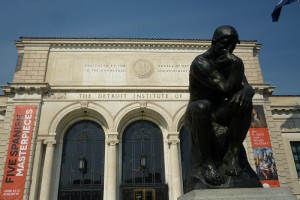
Auguste Rodin’s “The Thinker” (1904) greets visitors at the entrance to the Detroit Institute of Arts. The famous bronze was gifted to the museum in 1922. Photo credit: Quick fix via Flickr
Recent threats placed upon the Detroit Institute of Arts (DIA) have thrust the topic of deaccessioning once more into the popular spotlight. The DIA and its collection are owned by the City of Detroit, which has struggled financially for decades and was recently assigned a city emergency manager by the state’s governor Rick Snyder. In July, upon reviewing the city’s fiscal situation, the newly appointed emergency manager Kevyn Orr declared Detroit bankrupt. The federal government subsequently decided against bailing out the once mighty auto capital. Facing an estimated $18 billion in debt, creditors and pensioners are now hungrily eyeing the city’s various cultural, natural and infrastructural assets for potential liquidity. Among them is the DIA’s art collection, which has a market value estimated at anywhere from $2 billion to “the low to mid-11 figures.”
Those dollar signs are juicy enough to make any Detroit creditor’s mouth water, but it is important to remember that many of the holdings were donated to the museum under legal contracts with donors that ensured they would never be sold. An attempt to do so would likely result in multiple lawsuits filed by donors and their heirs. With those works legally safeguarded, the pieces most desirable to creditors are those that were bought by the city directly. Unfortunately for the DIA, these purchases comprise an important part of its collection.
Indeed, emergency manager Orr has already hired Christie’s auction house to appraise approximately 3,500 of the Detroit-purchased pieces. Among the lot are significant works by Brueghel, Tintoretto, and Matisse with estimated values reaching as high as $150 million each. These astronomically priced paintings are the superstar outliers within the 60,000 plus item collection, and they are the works most often cited as part of any prospective—and controversial—sale. There is no precedent for so many masterpieces being sold simultaneously, and there are fears amid the collector and auction community that a sale of this magnitude would depress the art market.

“The Window” (1916) by Henri Matisse was purchased by the City of Detroit in 1922 and reportedly has a market value of $150 million.
For the moment, the artwork is not under any immediate threat of seizure. The DIA has claimed the collection is in a public trust, legally defined as “a trust created for promotion of public welfare and not the benefit of one or more individuals.” The state’s Attorney General Bill Schuette echoed this sentiment in a formal statement issued in June. Although an Attorney General’s opinion traditionally carries significant legal weight, it is a possible that a court could overturn it, and creditors may seek just such a ruling if push comes to shove.
Should a court rule in favor of the creditors, selling the artwork to pay off the city’s debt would quite literally betray the public’s trust—though perhaps not the way that has deaccessioning foes concerned. The DIA is the beneficiary of a homeowners’ tax, or millage, passed just last year by voters in three counties to ensure it stays open and accessible to local residents. In fact, in response to recent developments, Oakland County’s Art Institute Authority recently passed a resolution calling for the termination of its contribution to the millage if a sale or leasing of any artwork goes forth. The other two counties, Wayne and Macomb, could follow suit. Without the levy, the museum would face a reduction of hours and museum exhibitions, at the very least.
Since Orr mentioned the collection as a potential asset back in May, battles of opinion have been waged between cultural critics and commentators that have resulted in an art world panic over the disbursement of the collection. In lieu of retired city employees facing reductions in their pensions, one prominent art critic suggested the collection be sold as a preventative measure, only to be browbeaten into switching his opinion.
At the center of these debates is the code of ethics of the American Alliance of Museums (AAM), which states that a museum’s collection may be sold “solely for the advancement of the museum’s mission . . . to be used consistent with the established standards of the museum’s discipline, but in no event shall [proceeds] be used for anything other than acquisition or direct care of collections.” The Association of Art Museum Directors (AAMD) upholds a similar ethical standard. In June, the Michigan Senate voted to approve a bill stating that all art institutions must adhere to this code. The art authority bill still has to be voted on by the House of Representatives when lawmakers return from their summer break, but one wonders if writing the AAM code into law is the right course of action.
Both the bill and Oakland County’s decision to end the millage pending a sale are intended to protect the DIA’s and taxpayers’ interests. But what happens to an institution whose hands have become tied legally? How will it affect the museum’s ability to decide what is best for it in the future?
In a Createquity post this May, Tegan Kehoe suggested “making responsible efforts to keep [deaccessioned] objects in public hands” as a reasonable standard that should avoid the worst outcomes of deaccessioning. But the proposed restrictions being placed upon the DIA would forestall even this approach. Let’s say the DIA wanted to invest in the goodwill of Detroit’s citizens by prudently selling or leasing artworks to other nonprofit institutions to help the city recover. According to Elliot Bostwick of Boston’s Museum of Fine Arts, as quoted in the New York Times, most museums only exhibit between two to four percent of their collection at one time. It’s entirely possible that among the museum’s more than 60,000 works—some of which will never be exhibited—there are items that no longer support the DIA’s vision. If executed carefully, a sale of these holdings could be seen as an act of generosity on the museum’s part and actually benefit the institution over the long term, while ensuring that the deaccessioned works remained accessible to the general populace. Yet with the art authority resolution in place and counties threatening to remove taxpayer support, the DIA could be held hostage by the very laws designed to protect its interests. (Indeed, director Graham Beal is now asserting publicly that “selling any art would be tantamount to closing the museum,” in no small part because of the millage situation.) There is an upside to allowing public institutions to police themselves via trade groups like AAM and AAMD.
From Kevyn Orr’s perspective, there are surely quicker and more efficient ways to raise funds for the bankruptcy proceedings than plundering works from the DIA. Some of those options include sale of the Coleman airport, Joe Louis Arena, Detroit-Windsor Tunnel, Belle Isle Park, parking operations, city-owned land, and the water and sewer department. Each of these assets comes with its own particular set of issues, but none seems quite as legally challenging as liquidating the DIA’s art collection. With museum advocates rallying for their cause and the press hot on Orr’s heels, any sale by the DIA, small or large, is becoming less likely by the day. Deaccessioning opponents may find reason to rejoice in that outcome, but whether it’s ultimately a good thing for the City of Detroit—or the DIA for that matter—is still a question worth asking.